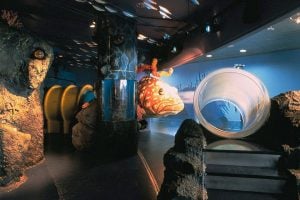Planeta Aqua is a large pavilion located at the end of the aquarium tour. There are several facilities with species adapted to different aquatic conditions. In the center of the room there is a shallow tank with guitar fish and rays, and in the circular loft, a series of aquariums dedicated to species characterized by their appearance, the practice of camouflage phenomena, symbiosis or because they are considered fossils living. Information panels on oceanography and environmental aspects are also available.
Nearly three quarters of our planet is covered with water. In spite of this, we know less about the oceans and their inhabitants than we do about the surface of the Moon.
After visiting our large aquariums and spectacular Oceanarium, the tour continues on the second floor. Planeta Aqua will help you discover many of the creatures that have adapted to the most diverse of aquatic environments: the bitter cold, the darkness of the deep, warm tropical waters. You can also admire the way different types of ray, such as freshwater stingrays and eagle rays, swim, thanks to an open tank containing 20,000 litres of water.
On Planeta Aqua’s circular mezzanine floor, you can observe living fossils and find out about phenomena such as camouflage, symbiosis, some secrets of oceanography and environmental issues. Through computer games, information panels, small aquariums and interactive elements, you can learn about the evolution of different mammals, reptiles and fish, which have all adapted to the marine environment.
Some of Planeta Aqua’s other exhibitions include:
Life in the cold
This installation shows a penguin colony with the possibility of observation on the surface and underwater. A specially-designed enclosure that replicates the natural climatic conditions of regions inhabited by the Humboldt penguin enables you to observe these animals even when swimming underwater.
The tropical universe
This space consists of the recreation of three sections of an Amazon river, where you can see iguanas, piranhas, and chameleons, among other species. In Planeta Aqua, we have also recreated the three main sections of a tropical river: the upper, middle and lower courses. At the mouth of these tropical rivers, we find particular ecosystems: mangrove swamps with their maze of roots where the young of many marine fish take shelter and feed. Here, you’ll have the opportunity to see certain exotic species, such as piranhas, tropical turtles and iguanas.
The world of darkness
Aquariums dedicated to jellyfish and benthic species are arranged inside the full-scale replica of a sperm whale. In this life-size sperm whale recreation, Planeta Aqua invites you to walk through the vastness of the marine universe and discover other remarkable ways of life, ranging from living organisms that drift around in areas still reached by light, such as jellyfish, to others that have adapted to the high pressures of the deep.
A pending search
A space dedicated mainly to children’s audiences where the history of ocean knowledge and the use of different oceanographic instruments is explained. This corner enables you to find out about the history of the conquest and knowledge of the oceans, and also how much still remains to be discovered. In the bathyscaphe, you can learn how some oceanographic instruments work and see what the inside of a submarine looks like.
Barcelona Aquarium
The Barcelona Aquarium, located in the Old Port of Barcelona, is the main and only large aquarium in the city and in Catalonia. In addition, it is the most important center in the world on a Mediterranean theme. The complex was opened in 1995.
There are aquariums and exhibitions, as well as a cafeteria, shop, photo souvenir, auditorium and other services. The Aquarium has 35 different aquariums, 11,000 animals from 450 different species, an 80 meter underwater tunnel with more than 100 people working on it.
In 2015 it was visited by 1,549,480 visitors, ranking fourth among the most visited attractions in the city of Barcelona, only behind the Sagrada Familia, Park Güell and the FC Barcelona Museum.




